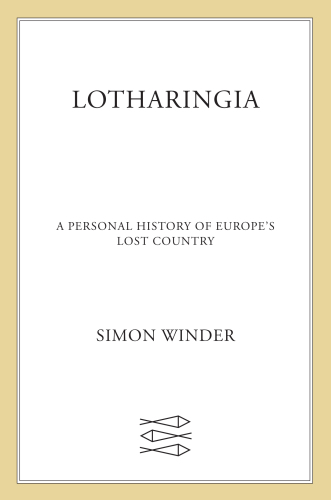
Lotharingia
A Personal History of Europe's Lost Country
کتاب های مرتبط
- اطلاعات
- نقد و بررسی
- دیدگاه کاربران
نقد و بررسی

March 11, 2019
In this combination travelogue and history, third in a trilogy, Winder (Danubia) leads an informative, often funny, but overly long tour of part of Charlemagne’s ninth-century empire, making a good case for its importance as “a key motor for so much of European history” up through WWII. In 843, Charlemagne’s grandsons Charles, Louis, and Lothair divided his vast empire. The western swath became France, the eastern Germany—and the “in-between” land, Lotharingia, gradually was absorbed into those two nations, plus Belgium, the Netherlands, Luxembourg, and Switzerland, over centuries of political and military tug of war. Winder defines Lotharingia, which didn’t last as a unit beyond Lothair’s death, as extending from the Rhine’s source in the north to the Alps in the south and guides readers to sites like Neuchâtel, whose young women were sought-after as governesses in Russia due to their speaking pure French, and Metz, known for its fortresses, with stops at cathedrals, museums, tombs, and other sites along the way. He also tells of characters like France’s “tiny, painfully awkward” Charles VIII, to whose futile conquest attempts in the 1480s and 1490s he credits the spread of both Parmesan cheese and syphilis. Readers may wish Winder’s editors had insisted on excising some minutiae, but they will both learn from and be entertained by this enthusiastic, outside-the-box European history.

Starred review from March 1, 2019
The final volume in London-based author and publisher Winder's trilogy about the history of Europe, following Germania (2010) and Danubia (2014).In this history of an ill-defined region of Europe--not quite Germany, not quite France, running along both sides of the Rhine, encompassing northern reaches of the Netherlands and including Flanders, Luxembourg, and Alsace-Lorraine all the way to Switzerland--the author brings the material rivetingly alive with the sheer elasticity of his imagination and prose. This region, "a mass of illogicality," was first defined after Charlemagne's death in 814 and named for one of his three grandsons, Lothair (thus, Lotharingia, created by 843), and it has "provoked wars in every century and...been the site of many of the events which have defined European civilization." Moving chronologically, Winder marvels at how little we know about this region before the onslaught of Julius Caesar. When the Roman general lifted the veil in The Gallic War, it appeared as "a series of highly organized, sophisticated societies, in terms of military technology hard for the Romans to defeat and with large, complex and tough ships designed for the harsh weather of the Atlantic." Tracing the disintegration of the invading marauders and the early Christian centuries' attempts to "erase all trace of native paganism," Winder enlivens his accounts with chronicles of his visits to many of these ancient archaeological grounds. Sifting through massive amounts of information covering centuries, he wisely structures the narrative around certain spots, such as Amiens or Beaune, and sharp profiles of notable historical figures--e.g., Hildegard von Bingen, "an obscure mystic from the twelfth-century Rhineland," or Dutch painter Hieronymus Bosch, whose paintings were created "to drive you onto your knees, to think about our fate in a fallen world." Throughout, Winder infuses his account with such energy and wit that readers may be pleasantly unaware of the many history lessons he imparts.A meandering and highly entertaining amble through fascinating bits of history that culminates in the horrors of the invading armies of the world wars.
COPYRIGHT(2019) Kirkus Reviews, ALL RIGHTS RESERVED.

Starred review from April 1, 2019
The final volume, following Germania (2010) and Danubia (2014), in Winder's personal history of Europe's Germanic language-speaking regions brings his subject to life with sympathy, verve, and erudition. One of the kingdoms carved from Charlemagne's empire in the ninth century, the territory of Lotharingia ultimately became Belgium, the Netherlands, parts of Switzerland, France, Germany, and Luxembourg. Tracing its history from the 840s until the current national borders were drawn after WWII, Winder offers vivid descriptions and reflections on the places, artworks, material cultures, and ideas that the region's various peoples created during a millennium of economic, religious, and technological innovation. He also clarifies the obscurities of its political history as a patchwork of disjointed small states sandwiched between France, the Habsburgs, and later Germany, all of which, along with the British, sought to turn it to their own purposes but failed to establish permanent control despite their meddling. Winder highlights the contrasts between readers' modern perspectives and those of the Lotharingians and their peers with a deft combination of personal observation, historical anecdotes, and humorously straightforward summaries of complex military, dynastic, and ideological conflicts. This work is highly recommended for fans of European and world history.(Reprinted with permission of Booklist, copyright 2019, American Library Association.)

























دیدگاه کاربران